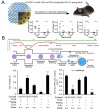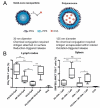Biomaterials for nanoparticle vaccine delivery systems
- PMID: 24848341
- PMCID: PMC4198431
- DOI: 10.1007/s11095-014-1419-y
Biomaterials for nanoparticle vaccine delivery systems
Abstract
Subunit vaccination benefits from improved safety over attenuated or inactivated vaccines, but their limited capability to elicit long-lasting, concerted cellular and humoral immune responses is a major challenge. Recent studies have demonstrated that antigen delivery via nanoparticle formulations can significantly improve immunogenicity of vaccines due to either intrinsic immunostimulatory properties of the materials or by co-entrapment of molecular adjuvants such as Toll-like receptor agonists. These studies have collectively shown that nanoparticles designed to mimic biophysical and biochemical cues of pathogens offer new exciting opportunities to enhance activation of innate immunity and elicit potent cellular and humoral immune responses with minimal cytotoxicity. In this review, we present key research advances that were made within the last 5 years in the field of nanoparticle vaccine delivery systems. In particular, we focus on the impact of biomaterials composition, size, and surface charge of nanoparticles on modulation of particle biodistribution, delivery of antigens and immunostimulatory molecules, trafficking and targeting of antigen presenting cells, and overall immune responses in systemic and mucosal tissues. This review describes recent progresses in the design of nanoparticle vaccine delivery carriers, including liposomes, lipid-based particles, micelles and nanostructures composed of natural or synthetic polymers, and lipid-polymer hybrid nanoparticles.
Figures





References
-
- Reed SG, Bertholet S, Coler RN, Friede M. New horizons in adjuvants for vaccine development. Trends Immunol. 2009;30(1):23–32. - PubMed
-
- Mbow ML, De Gregorio E, Valiante NM, Rappuoli R. New adjuvants for human vaccines. Curr Opin Immunol. 2010;22(3):411–416. - PubMed
-
- Brave A, Ljungberg K, Wahren B, Liu MA. Vaccine delivery methods using viral vectors. Mol Pharm. 2007;4(1):18–32. - PubMed
Publication types
MeSH terms
Substances
Grants and funding
LinkOut - more resources
Full Text Sources
Other Literature Sources

